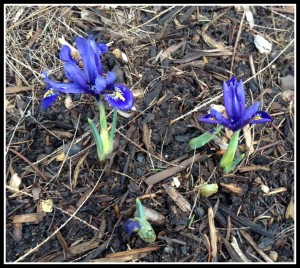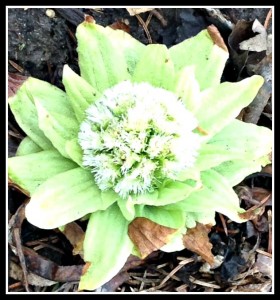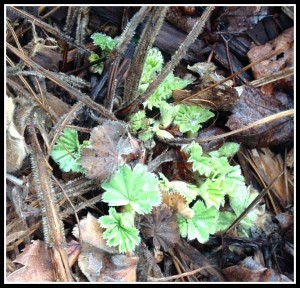Snowiest Winter on Record
Our most recent mid-March snow of six inches pushed the record books. It is now officially the snowiest winter ever in Southeast Michigan — over 90 inches.
Normally, at this time of year, I’d be venturing out on nice days to look for spring. I would lift up the dried plant tops to see the spring miracles underneath. This year, because of the snow cover, I’ll have to take a pretend journey. Come along with me …
First of all, the Red-winged Blackbirds are back in Serendipity Gardens, as detailed in last week’s post, so let’s enjoy listening to their strident, territorial calls as we look for signs of spring.
Most of the plants we will be looking for are not native to my region. I planted them long before I tuned in to the need to plant more natives, but at this time, I don’t intend to remove them. Going forward, I’ll be increasing my numbers of natives and planting wildflowers and common milkweed — all to support more wildlife, especially monarch butterflies. I encourage readers to do the same: feel free both to cherish existing plants AND to make a serious effort to add more natives to your garden.
Note: All photos are from last year’s early spring walk, the real thing! The words are my imagination.
Lady’s Mantle
First, let’s look to see if the Lady’s Mantle is coming up. Yes, there it is, down under the leaf litter. While the plant is not exactly beautiful here, you can see that the young leaves are pleated into fans. In early spring, it has frothy chartreuse blooms that look good with lots of other plants, and are drop-dead gorgeous paired with blue salvia. Plus, the plant has these rounded leaves all summer. When it rains, the fuzzy leaf surfaces hold droplets of water that roll around. Fun!
I started with two Lady’s Mantle plants. Today, from division, I have at least 12. They divide very easily, and do better when in light shade.
Hellebore
Now let’s go to the shade garden to see if the Hellebores are blooming. Oh, yes, they are! Even  in a super cold winter such as this, the Hellebores will bloom earlier than other plants, and the blooms last for a long time. The ones in my garden have creamy white blossoms, though I have seen them in other colors in garden catalogs. The dark green leaves look tattered by the end of the winter, but it’s a fairly simple job to cut the leafy stems off at the base. The plant will grow fresh new leaves that will be a beautiful dark green until the snow covers them up next winter.
in a super cold winter such as this, the Hellebores will bloom earlier than other plants, and the blooms last for a long time. The ones in my garden have creamy white blossoms, though I have seen them in other colors in garden catalogs. The dark green leaves look tattered by the end of the winter, but it’s a fairly simple job to cut the leafy stems off at the base. The plant will grow fresh new leaves that will be a beautiful dark green until the snow covers them up next winter.
These three plants took a year or two to settle in. I didn’t have much hope for them at first. But then they decided they felt at home, at which time they took off and grew to fill a space of about six feet square.
Iris Reticulata
 Okay, now let’s head back to the back pond. Everything in the garden for the most part still looks dry and brown. It’s hard to imagine that in just two months, green will be everywhere we look.
Okay, now let’s head back to the back pond. Everything in the garden for the most part still looks dry and brown. It’s hard to imagine that in just two months, green will be everywhere we look.
See those low-growing iris? Aren’t they just beautiful? I planted these bulbs for the first time last year, and it was exciting to see them come up in early spring. Their numbers are still sparse, but the blue flowers themselves are spectacular. Over time, these bulbs will expand their area and create a puddle of blue back here. The more blue the better — that is my garden philosophy.
Petasites Japonicus
Now let’s walk over to the big pond, I have something really weird to show you … the flower of the Petasites Japonicus. Look, here is one. They look rather like cabbages, I think — kind of  ugly, but interesting nevertheless. The first time I saw one, I had to consult a reference book to find out what it was. Now I look for them every spring.
ugly, but interesting nevertheless. The first time I saw one, I had to consult a reference book to find out what it was. Now I look for them every spring.
This plant has huge leaves — up to 24 inches in a season with adequate rain. I fell in love with the big leaves, and planted just one. I have at least 20 now, perhaps more. I would not recommend planting butterbur, as it is sometimes called, in a small space because it grows so strongly … but I love it in my garden.
Brrr! It’s Too Cold Out Here!
The weather is still frigid, and the snow is lingering. I wonder if these miracles of spring are happening anyway, under their cover, just as I have imagined. I expect they are, though they may be delayed a week or two.
I am very thankful for the deep snow cover we have had, because it has kept these plants and many more insulated from the fierce cold that people have contended with for much longer than normal.
In any case, spring is surely on its way. Remember, when planting time comes — plant something for the bees and butterflies this year! For ideas on what to plant, take a look at this chart.
